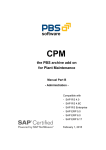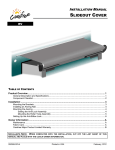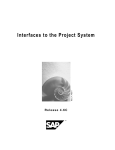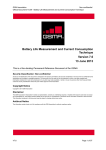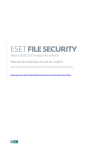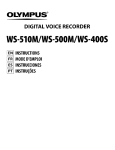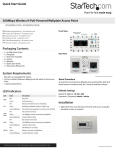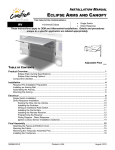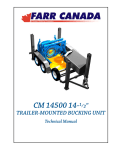Download PBS archive add on CPP - Manual Part B
Transcript
PBS archive add on CPP Production Orders Manual Part B - Administration - Compatible with SAP R/3 4.x SAP ERP 5.0 and 6.0 December 2, 2009 PBS archive add on CPP - Administration - © 1999 - 2009 PBS Software GmbH Schwanheimer Strasse 144a 64625 Bensheim, Germany Phone: +49 - 6251 - 174 0 Fax: +49 - 6251 - 174 174 Email: [email protected] Internet: www.pbs-software.com PBS archive add ons® is a registered trademark of PBS Software GmbH, Bensheim. SAP, R/3, SAP ERP, SAP NetWeaver, ABAP and others are registered trademarks of SAP AG, Walldorf/Baden. Acrobat Reader is a registered trademark of Adobe Systems Incorporated. 2 PBS archive add on CPP - Administration - Introduction to the PBS ILM Concept Information Lifecycle Management Information Lifecycle Management (ILM) means the administration of information related to the time when it is used, taking into account its total costs and compliance. A conclusive, efficient ILM concept must, as a result, control data growth, manage retention rules, and also ensure compliant data storage. Furthermore, an easy access to archived data is decisive and, for example, its transfer during internal and external audits. PBS ILM Concept PBS software provides existing SAP customers extensive solutions to put into practice the requirements that were described above for a stringent and successful ILM concept. PBS is considered as an expert for complex, integrated data accesses to archived and database data and meanwhile, also to data that is located on decommissioned SAP systems. In addition to classical SAP data archiving, SAP BI-specific nearline storage is also supported. PBS archive add ons® PBS archive add ons always rely on SAP archiving having been carried out successfully. This is the basis for a permanently high-performing SAP system. In principle, you can indeed retain posted documents in the SAP database for a very long time due to a large database capacity. Depending on the document volume, this may result, however, in massive performance losses and, sooner or later, heavily increasing operation costs. The daily backup becomes difficult for large data stocks, for example. A convenient display and evaluation of archived transaction data – as the SAP user is used to for database data – can often only be carried out in a very restricted manner using SAP standard means depending on the application module. This is particularly the case for large archive data stocks. The PBS archive add ons can be used here. They can be provided for nearly all SAP modules and release levels, and start with a "C" (for Complete) in their description. For example, PBS archive add on CCOPA for the SAP module COPA. Using the PBS archive add ons you can quickly and easily access your archived data even after data archiving during your day-to-day business. The unrestricted data access is realized by an intelligent indexing concept. It extends the SAP archive infrastructure components and integrates itself optimally with SAP archiving. Archive data that has been indexed can still be provided after a release upgrade immediately, without restrictions, and without migration effort. 3 PBS archive add on CPP - Administration - The PBS archive index is stored in sequential files of the SAP file system in the same way as the SAP archive data. Afterwards, you can access the archive data online via the familiar transactions. The SAP user can display the data from the SAP database and the archive data simultaneously via the PBS archive add on index. For the user, it seems as though the archived data is still in the SAP database. The deep integration of the PBS transactions also enables direct navigation to subsequent and previous documents both within the indexed SAP module as well as to linked documents from other SAP modules. This applies not only for resident but also without restrictions for archived data. The benefit for the user increases the more PBS archive add ons are used. The potential benefits of the ILM concept raises substantially if you take into account the savings that result from the SAP mirror systems. There are usually at least two of them meaning that the saved disk storage can be tripled by performing data archiving. Thus, time is saved for the data backup. 4 PBS archive add on CPP for SAP - Administration - Table of Contents 1. Introduction 6 2. Overview of the PBS archive add on CPP 7 2.1. 2.2. 2.3. 3. Construction of the PBS archive add on CPP 3.1. 3.2. 3.3. 3.4. 3.5. 3.6. 3.7. 3.8. 3.9. 3.10. 3.11. 3.12. 3.13. 4. Object Names Supplied Menus Basic Information on the PBS archive add on CPP Procedure Preparation of SAP Archiving Archiving of Production Orders Administration Board The Load Program /PBS/CPP_LDR3 Load Process Index Activation Further Load Processes Delete PBS Archive Index PBS Archive Utilities Path and Disk Space Long-Term Archiving Concept Summary Display Transactions of the PBS archive add on CPP 7 8 10 12 12 14 18 20 21 23 25 26 27 28 31 32 33 34 5 PBS archive add on CPP for SAP - Administration - 1. Introduction The PBS archive add ons are constructed in modular form and cover the application modules such as FI, SD, MM, CO with a special program package specifically for the application in question. You can easily see from the name which PBS archive add on belongs to which SAP module, for example, CFI, CSD, CMM, CCO. Something that all PBS archive add ons have in common, is that they can be easily installed in the SAP system via SAP transport utilities "tp" and SAINT. For further details on the installation of the PBS archive add ons please see the installation manual (manual part A). This administration manual was written to make construction and administration of the PBS archive add on CPP as easy as possible. At first, data archiving with SAP transaction SARA is discussed; the second topic is the construction of the PBS archive add on CPP from the SAP archive files. The modular user manual of each PBS archive add on is composed of partial manuals: - Part A: Installation - Part B: Administration, Archive Construction and Maintenance - Part C: Application Programs / Transactions There are additional manuals for the PBS utilities: Conversion Tool, Archive Browser, Translation Tool. Should you have questions or problems regarding the PBS archive add ons please call the PBS Software GmbH Service Hotline: Phone: +49 - 6251 - 174 110 Fax: +49 - 6251 - 174 174 Email: [email protected] Release Compatibility The PBS archive add on CPP discussed in this manual runs with the basis programs of SAP AG, 69190 Walldorf/Baden, for SAP system releases 4.0, 4.5, 4.6, R/3 Enterprise, ERP 2004 and ERP 6.0. 6 PBS archive add on CPP for SAP - Administration - 2. Overview of the PBS archive add on CPP 2.1. Object Names As already described in the installation manual (Part A), PBS Software GmbH has its own namespace from Release 4.0. The names of the programs and objects described in this manual originate exclusively from this namespace. For customers using an SAP release up to 3.1, we have listed below the objects of the PBS namespace used in this manual along with those for the releases up to 3.1. For a complete list of all objects please refer to the text file log.txt, which you receive with the transport (see installation manual). Object Rel. 4.x Rel. 3.x Description Program /PBS/CPP_LDR3 YYCPLOAD PBS load program Program /PBS/CPP_IDXG YYCPIDXG Activate PBS archive Program /PBS/CPP_SCAN YYCPSCAN Display PBS archive Program /PBS/CPP_ADMI YYCPADMI Insert index run into db Program /PBS/CPP_IDXD YYCPIDXD Deactivate PBS archive Program /PBS/CPP_DELR YYCPDELR Delete archive run Program /PBS/CPP_U001-9 YYCPU001-9 Test program Program /PBS/CPP_U050 YYCPU050 Technical display Transaction /PBS/YOA0 YOA0 Display production orders from database and archive Transaction /PBS/COA3 YOA3 Display archive data via PBS index Transaction /PBS/CO03 ZO03 Display production orders from database and archive Transaction /PBS/CPP YCPP Menu CPP Transaction /PBS/PBS ZPBS Menu PBS Table 1: Comparison of object names 7 PBS archive add on CPP for SAP - Administration - 2.2. Supplied Menus A menu is supplied with the PBS archive add on for all products and utilities of PBS Software GmbH as well as a special menu for the PBS archive add on CPP. Up to release 4.5 this menu can be started via the transaction /PBS/PBS (or ZPBS in 3.1). All programs described in this manual and the user transactions are contained in the menu. From release 4.6 the navigation has completely changed due to the implementation of the SAP Easy Access technique. This has also had an effect on the transactions in the environment of the PBS archive add ons. From these menus, you now have to generate activity groups (4.6B) and roles (from 4.6C) respectively, which then can be integrated into the user master. You can also create an activity group/role directly from the Easy Access menu. Diagram 1: Creating activity group/role You can freely define the name of the activity group/role; the name can also be within the PBS namespace. A PBS area menu is then transferred by pressing the function key 'Transfer menus from area menus' by indicating the corresponding PBS menu name. During the transfer, the system query for the explosion of the area menu should be answered with 'yes'. Diagram 2: Assignment to a user master 8 PBS archive add on CPP for SAP - Administration - The activity group/role created in this way can now be integrated in the corresponding user master. We recommend that the global activity group/role /PBS/PBS is assigned to the administrators and the special function menu /PBS/CPP to the end users. 9 PBS archive add on CPP for SAP - Administration - 2.3. Basic Information on the PBS archive add on CPP Construction and use of the PBS archive add on CPP always requires successful data archiving to have been performed using SAP means and access to the archive file created in this way. From 4.0B, this access can also be realized via an optical archiving system using “ArchiveLink”. In this case, the status of the archive file must be “Accessible”. The PBS archive add on CPP uses the archiving runs of the archiving objects: PP_ORDER production order Diagram 3: Status of the archive file You can determine the status of the archive files for the various archiving runs via transaction SARA. In order to display the documents correctly and realize the reporting via the PBS archive add on, the deletion run of the SAP archiving must have been successful. 10 PBS archive add on CPP for SAP - Administration - The generated SAP archiving runs are read and written into the file system of the PBS archive add on CPP (see installation manual) via the PBS load program /PBS/CPP_LDR3. During this process, secondary indices are created in the file system to enable efficient access. If a PBS archive already exists, the load program adds the new data from the SAP archive to this already existing archive. PBS Load program SAP Archive files Existing PBS archive New PBS archive Diagram 4: Construction of the PBS archive add on CPP Once the PBS archive has been constructed, it still has to be activated in the SAP system. For this purpose, please run ABAP /PBS/CPP_IDXG. The documents can now be displayed from the PBS archive add on. Chapter 3 of this manual describes the programs for the construction and the activation of the PBS archive add on CPP. 11 PBS archive add on CPP for SAP - Administration - 3. Construction of the PBS archive add on CPP 3.1. Procedure The archiving object PP_ORDER in the transaction SARA (SAP archiving tool) is used to archive production orders from the SAP database. The SAP archiving program PPARCHA1 archives the production orders in sequential files that can be accessed within the SAP file system. The archived production orders are then deleted from the database (PPARCHD1). The archived production orders can no longer be reloaded into the database. Via SAP transactions, the archived production orders can only be evaluated sequentially (transaction COA3 "Production Order Reorg: Display Archive Data", read program PPARCHR1). The reduced load on the database can be measured using the function 'Detailed Analysis' of the transaction DB02 or the transaction DB15. The generated SAP archive files can now be processed with the help of the load program of the PBS archive add on CPP. The load program reads the SAP archive files, creates secondary indices and stores this data in compressed form on magnetic disks outside the SAP database. Within the database, a subsequent run only stores a small amount of information in the table /PBS/CPP_ARCHIDX. To create the PBS index file the SAP Archive Development Kit (ADK) is also used, which simplifies the management of the PBS archive add on CPP, and allows a functionality identical to that of the SAP archiving objects. Thus it guarantees continuous functioning also in the case of release changes. The special archiving object of the PBS archive add on CPP is /PBS/CPP. The production orders that have been archived and then transported into the PBS archive add on CPP are again available online and can be evaluated easily with the PBS transactions. The PBS transactions are identical to the corresponding SAP transactions (e.g. /PBS/CO03 corresponds to CO03) from a functional point of view. Production orders can be read and displayed both from the SAP database as well as from the PBS archive add on CPP using the transaction /PBS/YOA0. 12 PBS archive add on CPP for SAP - Administration - A daily backup of the PBS archive add on CPP is – in contrast to the SAP database – not necessary as the archive data can no longer be changed. The SAP archive file that is created during the next reorganization of the database can be added to the existing PBS archive add on using the load program. Below we mention the most important topics you have to keep in mind when archiving production orders with SARA. Please refer to the corresponding SAP documentation before you archive and delete production orders from your database! The archive setup of the PBS archive add on CPP is described in the following chapters. 13 PBS archive add on CPP for SAP - Administration - 3.2. Preparation of SAP Archiving Having called the transaction SARA, enter the name of the archiving object (PP_ORDER). Now you can select different buttons to start the accessible functions. Diagram 5: Archive administration: PP_ORDER archiving Before the actual archiving of the production orders, the "Customizing" settings first have to be checked. Select the button "Customizing" in the initial screen of the transaction SARA. You are taken to the selection screen of the Customizing options for PP_ORDER (normally, no changes of the technical and the basis parameters are necessary). 14 PBS archive add on CPP for SAP - Administration - Diagram 6: Selection screen for Customizing options The user-specific settings must then be carried out: The residence time of the production orders in the database must be maintained using the transaction OPJH. First, the production order type to be processed, e.g. "PP01", has to be selected in a selection screen. Diagram 7: Definition of residence periods By clicking on the magnifying glass you are taken to the processing of the detail maintenance for the selected order type (here, PPS production order, PP01). For 15 PBS archive add on CPP for SAP - Administration - archiving, you only have to maintain here the residence time 1 and 2. Residence time 1 is related to the setting of the deletion flag, residence time 2 to the setting of the deletion indicator. After maintaining the residence times, the preprocessing program to set the deletion flag or the deletion indicator can be started. To do this, select the corresponding buttons or start the preprocessing program PPARCHP1 directly. The preprocessing program should be started in the background via a variant that has been defined correspondingly. Diagram 8: Detailed screen to maintain residence times 16 PBS archive add on CPP for SAP - Administration - Diagram 9: Selection screen of the preprocessing program The production orders to be processed are to be selected according to the entry options. In the areas "Actions" and "Options" you can now select the required processing, e.g.: test run or update run. You can reset the setting of the deletion flag, but not of the deletion indicator. 17 PBS archive add on CPP for SAP - Administration - 3.3. Archiving of Production Orders Having completed/checked the Customizing settings, you can start with the actual archiving of production orders from the database. The archiving program used for this purpose is started as a background job via a variant that is maintained by selecting the button "Archive" under "Actions" of the SARA initial screen. The selection of the production orders to be archived is carried out in the same way as the preprocessing via a corresponding selection screen. Under "Options" you can select by marking with a cross if the deletion run is first to be carried out only as a test run (in this case the update run for the deletion of the archived production orders must be started separately at a later time). Diagram 10: Selection variant for the archiving of production orders Having successfully completed the archiving runs, you can display the generated archive files by clicking the "Management" button. 18 PBS archive add on CPP for SAP - Administration - Diagram 11: SAP archive administration: display of the created archives 19 PBS archive add on CPP for SAP - Administration - 3.4. Administration Board The PBS Administration Board is the central administration instrument of the indices that have been generated using the ADK technique. Diagram 12: Administration Board of PBS archive add on CPP Icon Description By activating an index area the indices are made available to the user. Only deactivated index areas can be activated. Deactivating an index area means that the indices are no longer available to users. Deletion of an index area results in all dependent table contents and the physical files being flagged for deletion. The log of the run for an index area provides information about the number of processed indices, about the runtime and the selection criteria. By using the program /PBS/CPP_SCAN it is possible to select an index area and display its content. The index generation function enables you to index ADK files from the archiving object PP_ORDER. The indices are also stored in ADK files. The archiving object for this is /PBS/CPP. Table 2: Functions in the Administration Board 20 PBS archive add on CPP for SAP - Administration - 3.5. The Load Program /PBS/CPP_LDR3 The program /PBS/CPP_LDR3 is used for the construction of the archive index files of the PBS archive add on CPP. It generates all necessary indices for the archived production orders corresponding to each SAP archive file, together with the respective location of the production order in the SAP archive file. This index data is not stored in the SAP database but in the SAP file system on magnetic disk, using the ADK technique (Archive Development Kit) of SAP AG. Moreover, the program package of the PBS archive add on CPP contains the archiving object /PBS/CPP. This is used by the program /PBS/CPP_LDR3 to create a file for the archive index data that is completely identical to an SAP archive file. However, this file does not contain archived production orders but archive indices that you can use to access directly the archived production orders in the SAP archive files. Diagram 13: Selection screen of the load program /PBS/CPP_LDR3 21 PBS archive add on CPP for SAP - Administration - Parameters : Select manually: If this parameter is selected, the SAP archive files that are currently available are selected when you press the button "SAP archive". : Select automatically: If this option is selected, all available SAP archive files that were created after the date indicated are processed automatically as long as they match the maximum number of runs with a maximum number each. : Only prod. orders with basic finish date after Use this date to filter out data from the input based on its "last changed on" date. : Process all production orders from input If this option is selected, the SAP archive files that are selected automatically or manually are completely processed. : Process sequential number range from 1 to 999999999 This option enables the selection - be it automatic or manual – to be processed in several runs. The number indicated here has no relation to the process order number to be processed. All process orders of the selected SAP archive files are "counted up". : Set up additional indices In addition to the "standard indices" you can set up additional indices for "reservation number" or "component number". Both of these indices can only be evaluated by customer reports. 22 PBS archive add on CPP for SAP - Administration - 3.6. Load Process Having entered all necessary information in the selection screen of load report /PBS/CPP_LDR3, the selection screen can be saved as a selection variant and started as a background process. Important: The PBS archive add on CPP must be set up per client. During runtime the program generates the PBS archive add on for production orders from the archive data. Important: We recommend a data backup of the created files after each construction of the PBS archive add on. However, since a restart function is available for the load program, this is not really necessary. Job log: After each run of the load program a statistical report is generated, which can look as follows. This statistic can also be stored in the PBS archive add on and viewed later using the program /PBS/CPP_SCAN. User name: KRUEGER Date: 31.10.2003 Start of selection 15:11:08 Start processing archive : 012751-001PP_ORDER 15:11:08 Start processing archive : 012752-001PP_ORDER 15:11:08 Start processing archive : 012753-001PP_ORDER 15:11:08 Start processing archive : 012754-001PP_ORDER 15:11:08 Start processing archive : 012757-001PP_ORDER 15:11:08 Start processing archive : 012759-001PP_ORDER 15:11:08 Start processing archive : 012759-002PP_ORDER 15:11:08 Start processing archive : 012759-003PP_ORDER 15:11:08 Start processing archive : 012759-004PP_ORDER 15:11:08 Start processing archive : 012759-005PP_ORDER 15:11:08 End of Selection 15:11:17 Start SORT 15:11:17 End SORT 15:11:17 L O G S E T U P P R O G R A M C P P _ L O A D 23 PBS archive add on CPP for SAP - Administration - Number of input SAP archive runs (PP_ORDER)....: 5 Number of input records........................: 15 - number of input records not selected........: 0 Production order indices input exported - for order number ...AUFNR: 15 15 - for ord.cat/p.AUTYP/WERKS: 15 15 - for ord.type..AUART/KOKRS: 15 15 - for WBS element ....PSPEL: 0 0 DISPO: 15 15 - for prod. scheduler FEVOR: 15 15 - for material number MATNR: 15 15 KDAUF: 0 0 - for reservation no..RSNUM: 0 0 - for component.......KOMPO: 0 0 - for MRP controller - for sales order Archive data cluster exported - for order number ...AUFNR: 1 - for ord.cat/p.AUTYP/WERKS: 1 - for ord.type..AUART/KOKRS: 1 - for WBS element ....PSPEL: 0 - for MRP controller DISPO: 1 - for prod. scheduler FEVOR: 0 - for material number MATNR: 1 - for sales order KDAUF: 0 - for reservation no..RSNUM: 0 - for component.......KOMPO: 0 Diagram 14: Selection statistic of the program /PBS/CPP_LDR3 24 PBS archive add on CPP for SAP - Administration - 3.7. Index Activation After the PBS archive add on has been constructed using the load program /PBS/CPP_LDR3, the administration table /PBS/CPP_ARCHIDX has to be loaded into the SAP system. This table contains the current directory of the PBS archive add on CPP. For the update of the management table in question the report /PBS/CPP_IDXG is used, the request screen of which is shown in the diagram below. Diagram 15: Request screen of program /PBS/CPP_IDXG The parameter "Automatically all" can be used for activating all created stocks. Using the option "Automatically last one" only the last created stock is activated. It is also possible to select manually using the parameter "Manually". 25 PBS archive add on CPP for SAP - Administration - Diagram 16: CPP entries in table /PBS/CPP_ARCHIDX 3.8. Further Load Processes Due to the ADK technique of the load program used in the PBS archive add on CPP, merge runs are no longer necessary. A PBS archive index file is generated corresponding to each SAP archive file. Therefore, all further load runs have the identical procedure as in first load run. 26 PBS archive add on CPP for SAP - Administration - 3.9. Delete PBS Archive Index The archive indices created with the load program /PBS/CPP_LDR3 of the PBS archive add on CPP can, if necessary, be deleted. In this process, the program /PBS/CPP_DELR is used to delete the entries of the PBS archive indices from the database tables ADMI_RUN, ADMI_FILES, and /PBS/CPP_ARCHIDX. Furthermore, the created file in which the PBS archive indices are stored is physically deleted from the magnetic disk. Diagram 17: Selection for deleting index files that were set up The PBS archiving run to be deleted is selected from a list of archiving runs (multiple selection possible). The result of the deletion run is then displayed in the form of a log. Besides the deleted components of the PBS archiving run, a reference for the administration of the corresponding SAP archiving run is corrected, so that this run can be used again for the construction of a PBS archive index. Diagram 18: Display of the deleted components for an index run 27 PBS archive add on CPP for SAP - Administration - 3.10. PBS Archive Utilities The following utilities in the form of ABAP/4 programs are available for the management/test of the PBS archive add on CPP: Program Short description /PBS/CPP_SCAN PBS archive add on CPP: display contents /PBS/CPP_U001 Tech. Display production order from SAP archive /PBS/CPP_U002 Test access via index order number /PBS/CPP_U003 Test access via index order type/plant /PBS/CPP_U004 Test access via index order type/KOKRS /PBS/CPP_U005 Test access via index PSP-ELEMENT (SPROJN) /PBS/CPP_U006 Test access via index DISPONENT /PBS/CPP_U007 Test access via index production controller /PBS/CPP_U008 Test access via index material /PBS/CPP_U009 Test access via index customer order /PBS/CPP_U050 Tech. display of the PBS archive file contents Table 3: PBS archive utilities A very useful tool for checking/managing the PBS archive add on CPP is the program /PBS/CPP_SCAN. This program allows a (technical) view into the data archived with the PBS archive add on CPP. You can display the contents of the secondary indices in question, the references to the production orders themselves, as well as administrative information of the PBS archive add on CPP. When doing this, the header entries of the “data cluster“ used for the storing and – via selection of certain header entries – the corresponding detailed information is displayed in a basic list. By selecting "Statistics load program", you can display the setup logs of all load program runs of the program /PBS/CPP_LDR3 that have been carried out up to now. 28 PBS archive add on CPP for SAP - Administration - Diagram 19: Delimitations of the program /PBS/CPP_SCAN Diagram 20: Basic list for the index "order number" 29 PBS archive add on CPP for SAP - Administration - Diagram 21: Detailed list for the first cluster of the basic list Further Utilities: The utilities /PBS/CPP_U001 to /PBS/CPP_U009 are examples and are used to demonstrate the access routines of the PBS archive add on CPP. These utilities can be particularly helpful when adjusting customer-specific programs to the PBS archive add on CPP. /PBS/CPP_U050 displays the corresponding secondary indices of the PBS archive add on CPP directly from the archive file. The program thus checks the readability of these archive files of the archiving object /PBS/CPP. The document number of the file to be displayed can be taken from the load program log. The program /PBS/CPP_U050 can be started before /PBS/CPP_IDXG writes the table of contents into the table /PBS/CPP_ARCHIDX of the database. 30 PBS archive add on CPP for SAP - Administration - 3.11. Path and Disk Space The PBS archive add on CPP is set up in database-independent file systems. The system administrator’s task here is to reserve free memory capacity for construction of the PBS archive index. If the directory (ARCHIVE_DATA_FILE) suggested in the SAP file system is not to be used, you can use the transactions AOBJ and FILE to enter a separate directory for the PBS archiving object /PBS/CPP. If necessary, this directory must also be created physically on the magnetic disk. The amount of disk space to be made available depends on the number of production orders that are to be kept in the PBS archive index. In order to store the complete index data for an archived production order, about 100 bytes are required. An additional 5 bytes per document for management information which is kept in the SAP database must also be reckoned. Performance and runtime during the construction of the archive indices of the PBS archive add on CPP strongly depend on the efficiency of the system that is used and the data volume to be processed. 31 PBS archive add on CPP for SAP - Administration - 3.12. Long-Term Archiving Concept Many users have to retain production orders that were archived in the PBS archive add on CPP accessible online for a long period (for example more than five years). If, additionally, the data volume is very large, the complete data volume archived in the PBS archive add on CPP can increase so much that a good performance of the online accesses to the PBS archive is no longer possible, even in the case of an efficient system. To reduce the data volume that is accessed online, the user may wish to occasionally “switch off” one or more archive runs of the PBS archive add on CPP from online access, without deleting the actual PBS archives. As the indices of the different archive runs are not merged in the PBS archive add on CPP, this wish can be easily fulfilled by the utilities of the PBS archive add on CPP: only the entries in the administration table referring to a certain PBS archive run of the PBS archive add on CPP have to be deleted to exclude this specific archive run from online access. This process can easily be reversed again: you only have to add the entries of the administration tables – that in a way represent a type of table of contents for the PBS archive add on CPP – for the (existing) PBS archive runs again. The "deactivated" PBS archive runs (PBS indices and original SAP archive files) can be archived on any media, provided they are not used. The easiest way is to remove them using SAP ArchiveLink to an optical archive or to an HSM system. From there, they can easily be loaded back if required. To deactivate specific PBS archive runs, proceed as follows: From the main menu /PBS/CPP, start the menu option Archive => Additional Tools => Deactivate index. Select those PBS archive runs of the PBS archive add on CPP that you want to exclude from online access from the option “File list”. Before carrying out this step, we recommend you to use the archive tool of CPP and write down the corresponding SAP archive files from the run logs, in case you want to transfer the SAP archive files and the PBS indices of the PBS archive add on CPP to a separate storage medium afterwards. Now start the program with your selection. To enable online access to the PBS archive runs of CPP that have been "switched off" again, simply start program "Load Admin.Table" from the “PBS archive” menu of the PBS archive add on CPP. First you only need to place the PBS index file and the corresponding SAP archive file in the original file directory. 32 PBS archive add on CPP for SAP - Administration - 3.13. Summary Archiving of production orders from the SAP database using the transaction 'SARA' (or 'CO78' respectively) for the archiving object PP_ORDER. Construction of the PBS archive indices for the SAP archive files via the PBS archive add on CPP using the program /PBS/CPP_LDR3. Loading of the archive table of contents of the PBS archive add on CPP into the table /PBS/CPP_ARCHIDX using the program /PBS/CPP_IDXG. Testing the archive access using the PBS utility /PBS/CPP_SCAN. 33 PBS archive add on CPP for SAP - Administration - 34 4. Display Transactions of the PBS archive add on CPP The transactions of the PBS archive add on are explained in detail in manual part C (user manual). This chapter only gives a general overview of the supplied transactions in the PBS namespace and for the SAP release 4.x. PBS SAP Transaction Description /PBS/CPP -/- Menu of the PBS archive add on CPP /PBS/YOA0 -/- Display production orders from database and archive /PBS/COA3 COA3 Display archive data via PBS index /PBS/CO03 CO03 Display production orders from database and archive Table 4: Transactions of the PBS archive add on CPP



































